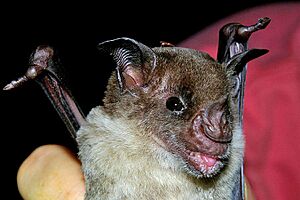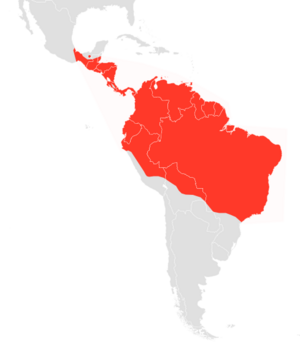Pale spear-nosed bat facts for kids
Quick facts for kids Pale spear-nosed bat |
|
|---|---|
 |
|
| Conservation status | |
| Scientific classification | |
| Genus: |
Phyllostomus
|
| Species: |
discolor
|
 |
|
| Pale spear-nosed bat range | |
The pale spear-nosed bat (Phyllostomus discolor) is a type of bat found in parts of South America and Central America. It's known for its unique nose shape, which looks a bit like a spear!
Contents
About the Pale Spear-Nosed Bat
These bats are quite strong for their size. Adult bats are usually about 8 to 11 centimeters (3 to 4 inches) long. Their wings can spread out to about 42 centimeters (16.5 inches). Male bats are a bit bigger than females. Males weigh around 45 grams (1.6 ounces), while females weigh about 40 grams (1.4 ounces).
Their fur can be different colors. It might be a light yellowish-brown or even a very dark, almost black shade. Their chest and belly are much lighter, often white or light gray.
Wings and Face Features
Pale spear-nosed bats have large wings with rounded tips. This helps them fly well. They also have a large membrane (skin flap) between their legs, called a uropatagium. This membrane goes all the way to their ankles. Their tail is short and pokes out from the top of this membrane.
Their face is wide with a short nose and a rounded head. They have a special nose-leaf that looks like a long, wide spear pointing upwards. Their ears are also wide and long. Males have a special gland in their throat. This gland is almost completely missing in females.
Where They Live: Habitat and Range
You can find pale spear-nosed bats from southern Mexico all the way down to northern Peru, Bolivia, and Paraguay. They also live across southeastern Brazil. They prefer to live in lowland forests and farm areas. They can be found at heights up to 610 meters (2,000 feet) above sea level.
There are two main types, or subspecies, of this bat:
- Phyllostomus discolor discolor: This type lives in most of Colombia, eastern Ecuador, Venezuela, the Guianas, Bolivia, Peru, Paraguay, and Brazil.
- Phyllostomus discolor verrucosus: This type is found in Mexico, Central America, and parts of Colombia and Ecuador west of the Andes mountains.
What They Eat and How They Behave
Pale spear-nosed bats are nocturnal, meaning they are active at night. During the day, they rest in hollow trees or inside caves. They live in large groups called colonies, which can have up to 400 bats!
Inside these big colonies, bats gather in smaller groups. Some groups are all males. Other groups have one male and up to 15 females. Females sometimes move between these groups. Females in a group often groom each other, but they can be aggressive towards bats from other groups.
Diet: What's on the Menu?
These bats are omnivores, meaning they eat both plants and insects. A big part of their diet is nectar, pollen, and flowers. When they visit flowers, they help to pollinate them. This is very important for plants like soari trees.
While they mostly eat plant material, in some areas, insects are a more important food source. For example, they might eat nectar during the dry season. Then, they switch to eating insects like beetles, bugs, flies, and moths during the wet season.
When they are looking for food, pale spear-nosed bats often fly in groups of up to 12. They fly in a single line and take turns visiting flowers. To get nectar, they fly back and forth until the flower is empty. They only land for a very short time before flying off again.
Amazing Echolocation and Communication
One cool thing about these bats is how they use echolocation. This means they send out sounds and listen to the echoes to "see" objects around them. They can figure out the shape of objects using echoes, no matter how big the object is. However, loud background noise can make it harder for them to recognize objects.
Pale spear-nosed bats have many different calls, up to 20! This is a very complex way to communicate, similar to some primates. Besides sounds, male bats also mark their resting spots with a special scent from their throat glands. Both male and female bats can recognize specific males just by their smell.
Life Cycle: How They Reproduce
Mating mostly happens within the smaller groups of bats. Sometimes, females might be chased by males from outside their group before mating. The time of year they mate can be different depending on where they live. In Guatemala, it's mainly in the summer. But in Brazil, it seems to happen all year round. The time it takes for a baby bat to grow inside its mother can also vary.
Baby bats are born almost without hair. But they already have whiskers and some hair on their legs and the membrane between their legs. At first, the mother carries her baby with her when she hunts for food. After a few days, she starts to leave them at the roost. Other adult bats in the group accept the young bats. Sometimes, baby bats even cling to the main male of the group.
Young bats can fly when they are about five to six weeks old. They are fully weaned (stop drinking milk) by three months. If a baby bat gets separated from the adults, it makes special ultrasonic distress calls. They don't start making echolocation calls until about ten days after they are born. Their first calls are longer and have louder low sounds. But by the time they start flying, their calls sound like adult bats.
Images for kids




